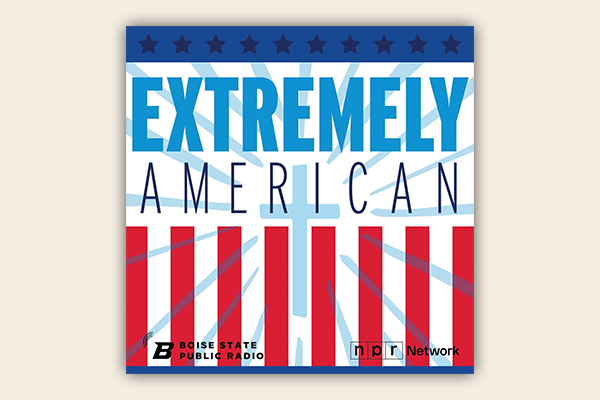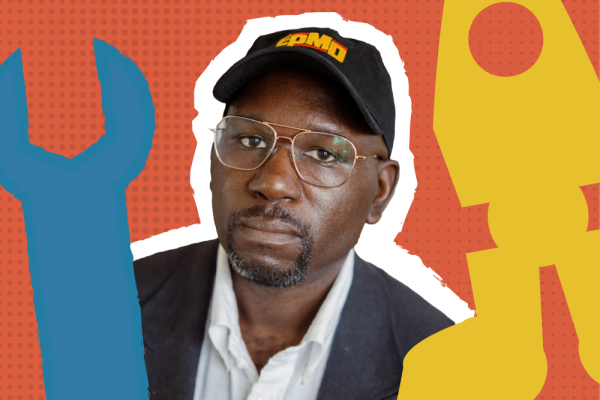My partner, Amanda, knew she wanted to try out for roller derby when Princess Poppycock eyed her up and down, grinned like a wolf, and said, “Yeah, we could definitely use you.” When Amanda tells the story now, she always says, “There aren’t a lot of sports where a body like mine is desirable. But that’s the great thing about roller derby — no matter how big or little you are, no matter how young or old, there’s a space for you in derby.” From the first time she walked into an arena to watch a bout, she experienced the space as a liberating one — a place she could be fully herself.
For the past six years, she has skated as “Mother Terrorista,” and in the last couple of years, I have volunteered as an announcer for the league (as “Father Terrorista”). Over these years, we’ve both experienced roller derby as a freeing space — one that offers more of a sanctuary to women and queer people than many of the churches I have grown up in and pastored.
Churches far too often operate under the “male gaze.” The male gaze, a term I'm borrowing from film criticism, always answers the question of “Who is this for?” with “Well, men, of course.” Some congregations, even though they affirm women pastors, worship directors, and singers, still caution them to dress so that the men in the congregation don’t find them “tempting.” The male gaze is always cisgendered and heterosexual, so churches that are formed by the male gaze are structured to be hostile toward queer people (no matter how kind congregants in those churches are to queer individuals).
The church could learn a thing or two from women’s sports. Women’s sports have long created spaces for flourishing — not just for women of all shapes and sizes, but for queer people too. Women and queer people create these spaces by subverting the male gaze and redefining the public perception of sports.
Of all women’s sports, roller derby has the distinction of being the oldest sport that’s featured an identical set of rules. Created in 1935 by an event promoter named Leo Seltzer, a bout (what derby games are called) features 10 skaters per jam (a “jam” is like an inning in baseball). One skater wears a star on their helmet; they’re the “jammer.” Every time the jammer passes an opposing skater their team scores a point. The other skaters are “blockers,” who play both offense (making openings for their jammer) and defense (stopping the opposing jammer from passing them).
In the nearly 90-year history of the sport, its popularity has waxed and waned. At its peak in the 1970s, championship bouts were selling out Madison Square Garden. According to oral history, the roller derby players explained to me that this was also when the male gaze was most evident: Women wore fishnets, fights were staged, and skaters who received penalties went to the “Sin Bin” where they received spankings. Not long after that, however, derby’s popularity waned to the point that it seemed done for good.
Ultimately, the pattern of fluctuating popularity is common across all women's sports. The most recent derby revival began in Austin, Texas, in 2001, and today, the Women’s Flat Track Derby Association has more than 400 member-leagues all over the world. Since the beginning, this resurgence has had a decidedly queer, feminist character.
Roller derby is far from the only queer women’s sport. The Amazon series A League of Their Own illustrates how difficult it has been for women who play sports professionally to find these kinds of spaces where they can flourish outside of the male gaze. In the first episode, we meet chocolate bar king Mr. Harvey (based on Philip K. Wrigley who gained his fame thanks to chewing gum). In 1943, Harvey created the All-American Girls Professional Baseball League to sell the spectacle of “girls” playing a man’s sport. As the women take the field for tryouts, Harvey complains that the women aren’t “ladylike and feminine.” Player introductions include their feminine (aka “appropriate”) hobbies like house-making and knitting. Despite Harvey’s desire for spectacle, the women who made the teams were determined to claim the space as their own sport.
In their book, Hail Mary, Frankie de la Cretaz and Lyndsey D’Arcangelo trace the history of the National Women’s Football League (1974-1988). Thirty years after the AAGPBL, the women of the NWFL faced the same struggles: In the press, the players’ looks were always described before their playing abilities.
Like Wrigley (and the fictionalized version, Harvey) before them, the advertisers of the NWFL wanted women who conformed to a specific image of femininity to attract male viewership. De la Cretaz and D’Arcangelo observed, “Despite the fact that the [Toledo Troopers] had over twenty women on the roster, none of them, aside from [Linda] Jefferson, was deemed attractive enough to be used to promote the franchise they were responsible for making successful.”
Whether it’s baseball, football, roller derby, or any other sport, women have always struggled to be taken seriously as athletes. Despite this, the women — many of whom were queer like baseball pioneer Maybelle Blair — subverted expectations and created spaces of liberation.
Abbi Jacobson, who co-created the A League of Their Own series and stars as Carson Shaw, sought the blessing of Penny Marshall, the director of the original 1992 film. Jacobson’s series is a remake in the fullest sense of the word insofar as she tells Black and queer stories that were left out of the original film. Her show creates space for the stories of women like Maybell Blair — who inspired D’arcy Carden’s character Greta, a bisexual player who introduces Shaw to queer culture. After consulting on the show, Blair came out publicly at 95 years old.
In its penultimate episode, A League of Their Own reminds us that spaces controlled by the male gaze are dangerous for women, queer people, and everyone else. This reality should move churches to lament. We are guilty of centering the male gaze, evident in our support of conversion therapy, homophobic rhetoric, and outright lies about the queer community told from the pulpit. So, what can we learn about queer holiness from sports like roller derby or TV shows like A League of Their Own? Here are four ways the church can learn from women’s sports.
- First, be a good fan (celebrate the queer community).
Churches should consider how to enter spaces that are already queer affirming — like women’s sports or drag shows. Mobilizing a church community to show up at Pride events — as Austin New Church made headlines doing — demonstrates to queer neighbors that a church is working to be hospitable. When several pastors in Rowlett, Texas, where I live, protested our city observing Pride month by lighting our water tower in rainbow colors, I spoke out at our local city council meeting, using my role as a pastor to affirm our city’s recognition of our queer citizens.
- Send the male gaze to the Sin Bin (reject patriarchal religion).
Roller derby has discarded many features the male gaze imposed on the sport — like the Sin Bin and its spankings; it has subverted others — people now wear fishnets and makeup to empower themselves and not to appease men. Do our churches police female dress in the name of protecting men from lusting? Do our membership policies exclude queer relationships?
- Learn the rules (queer the church).
Roller derby is a space for queer and trans women and non-binary persons to flourish. Can we say the same about our congregations? We need to interrogate how the male gaze has shaped our theology, denomination, and local church. Are we working to dismantle cisgendered, heterosexual assumptions within ourselves (what the queer community sometimes calls “queering ourselves”)? Are we reading queer theologians, are we queering biblical texts as we teach and preach them? Are we working to dismantle hierarchies rooted in gendered power dynamics?
- Good coaches matter (elevate queer voices).
Roller derby, as it exists today, was revived by women and queer people. So too, in A League of Their Own: the male manager, Dove Porter (Nick Offerman), is only present for three episodes. After his departure, the onus of leadership falls to Shaw, whose leadership (eventually) allows every woman on the team to flourish. If your church is serious about the work of liberation, then it will empower women and queer people to be in positions of decision-making: Pastors, elders, church board members, et al.
Those of us in churches that are not historically queer affirming but have a desire to repent of our queer-phobia and become a space of flourishing for women and queer people have a lot of work to do (my congregation certainly does). But this is the call of liberation, to center those the larger culture marginalizes, to find among the least of these the very person of Jesus himself. As ever, the Spirit is already ahead of us, working in surprising ways and unexpected spaces. If we will humble ourselves and attend to those spaces, we find an invitation to join God’s liberating work. In responding, we find ourselves liberated as well.
Got something to say about what you're reading? We value your feedback!







